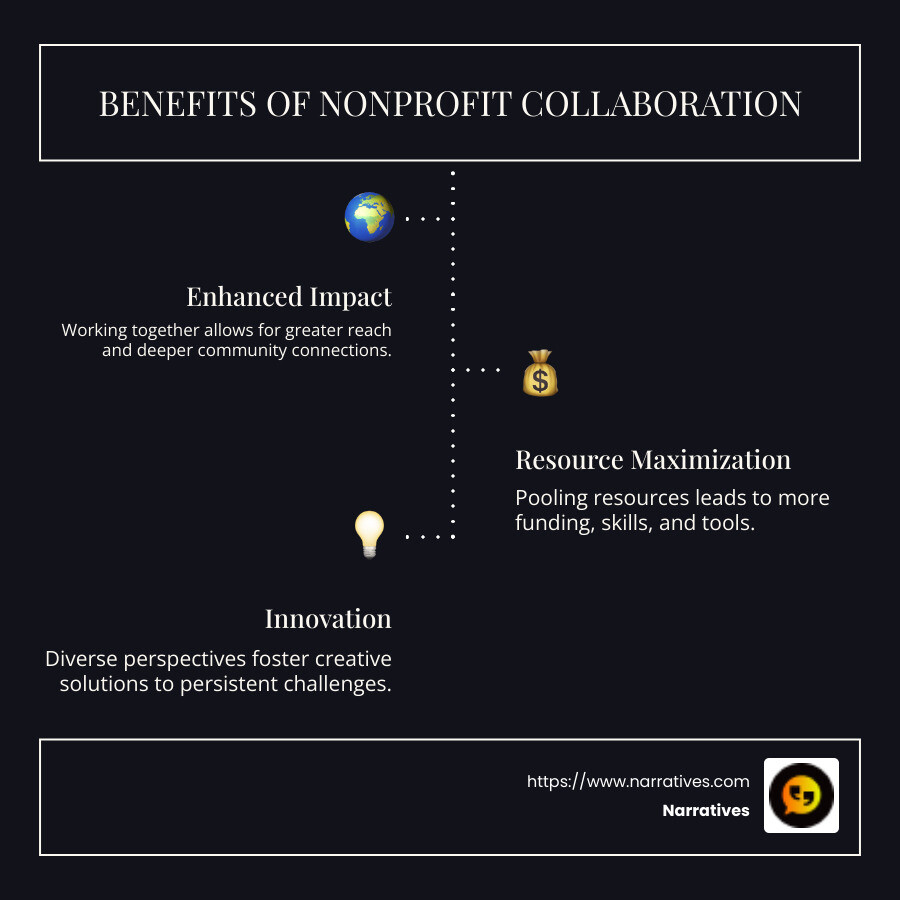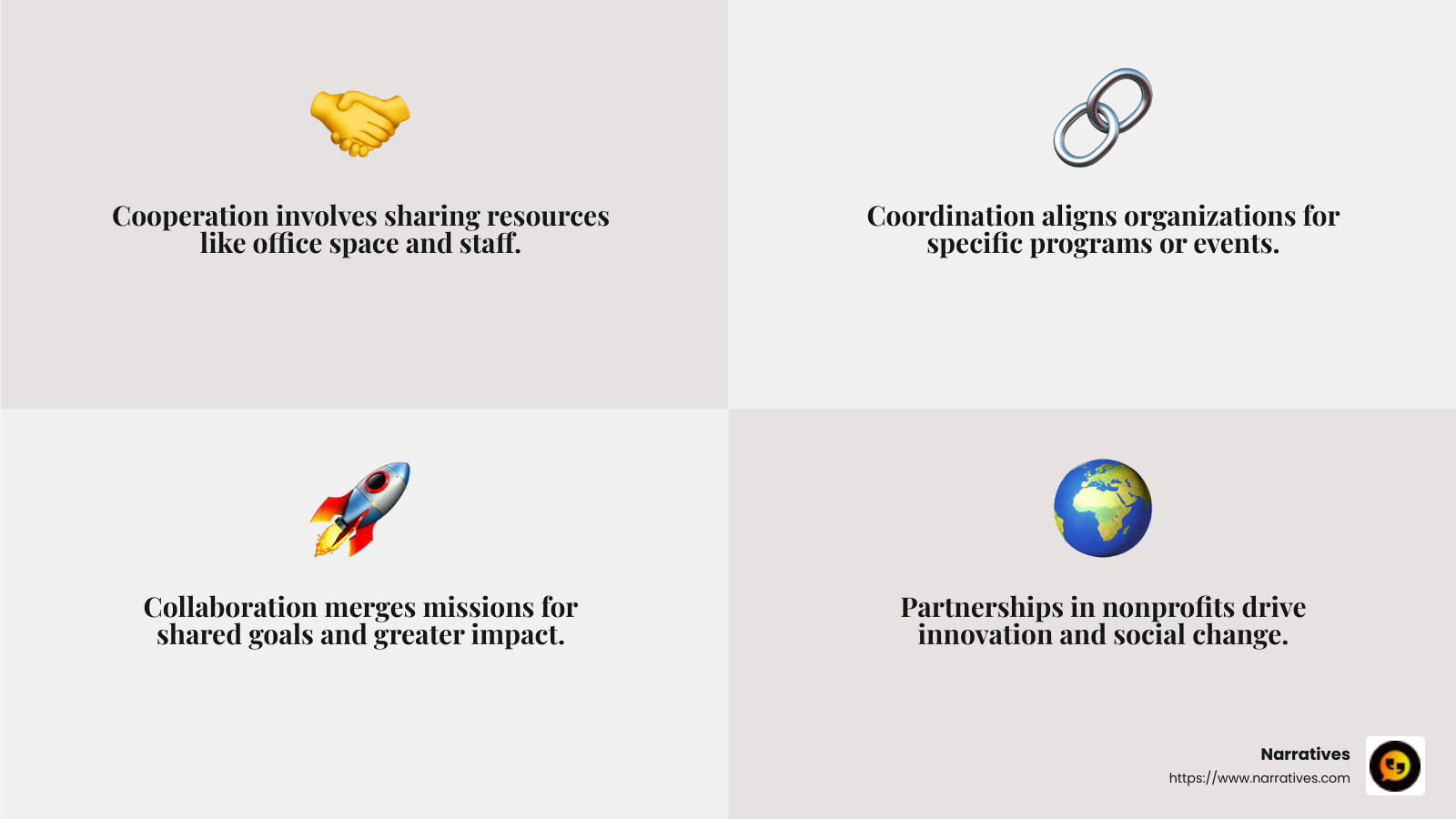Together We Thrive: Unlocking the Secrets of Nonprofit Collaboration

Nonprofit collaboration is becoming increasingly necessary in a world where complex problems demand innovative solutions. At its core, nonprofit collaboration involves multiple organizations working together to amplify their impact. These partnerships help nonprofits pool their resources and expertise, tackle larger issues together, and ultimately drive social change.
Here’s a quick breakdown of why nonprofit collaboration matters:
- Improved Impact: Shared goals mean bigger reach and deeper community connection.
- Resource Maximization: Collaborate to access more funding, skills, and tools.
- Innovation: Diverse perspectives lead to creative solutions for persistent challenges.
- Increased Efficiency: Shared resources can reduce costs and duplication of efforts.
One inspiring example is the Diverse Books for All Coalition, a collaboration of over 30 nonprofits to make diverse children's books more accessible and affordable—a critical step in supporting educational and racial equity.
When we think about tackling big issues like community well-being or environmental justice, strategic partnerships between nonprofits are not just beneficial; they are essential. Finding common ground and fostering open communication are key to these relationships that have the potential to redefine what's achievable.

Why Nonprofits Collaborate
Nonprofits are increasingly turning to collaboration as a way to boost their effectiveness and reach. But why is nonprofit collaboration so important?
Efficiency
When nonprofits join forces, they can operate more efficiently. Pooling resources means that organizations can share costs and reduce duplication of efforts. For example, two nonprofits might share office space or hire a joint marketing consultant. This not only saves money but also allows each organization to focus more on their mission.
Community Impact
Collaboration can significantly amplify a nonprofit's impact on the community. By working together, organizations can tackle bigger issues and reach a wider audience. The Diverse Books for All Coalition is a great example. By combining efforts, over 30 nonprofits are making diverse children's books more accessible, which supports educational and racial equity. Such collaborations can lead to systemic change and greater community well-being.
Shared Resources
Shared resources are a cornerstone of effective nonprofit collaboration. This means not just sharing physical resources like office space or technology, but also intangible resources like expertise and networks. For example, Big Bang Philanthropy is a collective where major donors share their knowledge to connect with poverty-alleviating nonprofits, amplifying their collective impact.
By working together, nonprofits can create a more powerful force for change. They can address issues that are too large or complex for any single organization to tackle alone. This kind of strategic partnership allows nonprofits to not only survive but thrive in their mission to make the world a better place.
Next, we'll explore the different types of nonprofit collaboration and how they can be structured for maximum effectiveness.
Types of Nonprofit Collaboration
Nonprofits can collaborate in various ways, each offering unique benefits and challenges. Let's explore three main types: cooperation, coordination, and collaboration.
Cooperation
In a cooperative relationship, nonprofits come together to share resources—both tangible and intangible. This might involve sharing office space, software, or even staff members. For instance, two organizations might jointly hire a designer they couldn't afford individually.
A great example of cooperation is Big Bang Philanthropy. Here, major donors pool their knowledge and resources to support poverty-alleviating nonprofits. This collective effort allows each member to donate at least $1 million annually, creating a massive impact globally.
Coordination
Coordination takes collaboration a step further by aligning organizations around specific programs or events. This type of partnership requires a greater commitment of time and resources but often leads to more significant rewards. By coordinating efforts, nonprofits can reach broader audiences and save money.
Consider InterAction, a collective of over 180 nonprofits focused on global disaster relief. Through coordination, these organizations benefit from professional advocacy to Congress, enhancing their ability to influence policy and secure government funding.
Collaboration
Collaboration is the most transformative type of partnership. Here, nonprofits merge their missions and structures to work towards shared goals. This deep level of partnership involves clear planning and measurement of objectives.
An inspiring case is the merger between Chicago Youth Centers (CYC) and Family Focus. By joining forces, they cut costs and improved services for children from birth to age 3. This merger allowed them to provide better community services and achieve more significant social impact.

Through these structured partnerships, nonprofits can open up innovation and accelerate positive change. By understanding and implementing these types of collaboration, organizations can amplify their impact and tackle complex social issues more effectively.
Next, we'll dive into how to build successful nonprofit collaborations and create lasting partnerships.
How to Build Successful Nonprofit Collaborations
Building successful nonprofit collaborations is like crafting a strong bridge. It requires the right materials, a solid foundation, and careful maintenance. Here’s how you can create lasting partnerships:
Open Communication
Communication is key. Think of it as the glue that holds the partnership together. Open and transparent communication ensures everyone is on the same page. Regular check-ins, updates, and discussions about both successes and challenges are essential. This not only builds trust but also helps prevent misunderstandings.
Imagine a partnership as a team of rowers. If they don't communicate, they might row in different directions. But with clear signals and shared understanding, they can glide smoothly towards their destination.
Shared Goals
Shared goals are the compass guiding your collaboration. Without a common direction, efforts can become scattered and ineffective. Start by aligning on a mission that resonates with all parties involved. This shared vision is what keeps everyone motivated and focused.
For example, when Chicago Youth Centers and Family Focus merged, their shared goal of improving services for young children was the driving force behind their collaboration. This common purpose enabled them to pool resources and achieve more together than they could alone.
Clear Roles
Imagine a play without a script or defined roles. Chaos, right? The same goes for nonprofit collaborations. Defining clear roles and responsibilities ensures that everyone knows what they’re supposed to do. This clarity prevents overlaps and gaps in work, making the collaboration more efficient.
A well-structured partnership is like a well-rehearsed orchestra. Each member knows their part, and together, they create beautiful harmony.
By focusing on open communication, shared goals, and clear roles, nonprofits can build partnerships that are not only successful but also transformative. These elements form the backbone of any thriving collaboration, enabling organizations to work together seamlessly and achieve greater impact.
Next, we'll explore how to overcome common challenges in nonprofit collaboration.
Overcoming Challenges in Nonprofit Collaboration
Navigating nonprofit collaboration isn't always smooth sailing. Organizations often face problems that can hinder their ability to work together effectively. Let's explore some common challenges and how to tackle them.
Differing Missions
One of the biggest roadblocks is when nonprofits have different missions. It's like trying to fit a square peg into a round hole. Organizations may have unique approaches to social issues, making it tricky to find common ground.
How to overcome this: Start by conducting a thorough assessment of each organization’s mission and objectives. Identify overlapping areas and shared values. Open communication channels and engage in collaborative goal-setting sessions to create a unified vision. This approach was highlighted in a Forbes article that emphasized the importance of finding common ground for successful collaboration.
Limited Resources
Most nonprofits operate with limited resources, making collaboration seem impractical. When both entities are struggling, sharing resources might feel like spreading themselves too thin.
How to overcome this: Be creative in pooling resources. Share infrastructure like buildings, vehicles, or staff. Combine fundraising efforts or apply for grants together. This collaborative resource-sharing can amplify the impact of both organizations. As noted in the Narratives article, scarcity should not turn potential teammates into competitors. Instead, it should encourage innovative ways to work together.
Communication Challenges
Effective communication is crucial, but aligning strategies and styles across organizations can be tough. Misunderstandings can derail even the most promising partnerships.
How to overcome this: Establish clear lines of communication from the start. Develop a communication plan with regular check-ins and shared project management tools. Designate a point of contact from each organization to streamline interactions. This helps prevent misunderstandings and fosters a collaborative environment.
By addressing differing missions, limited resources, and communication challenges, nonprofits can build stronger collaborations. In the next section, we'll answer some frequently asked questions about nonprofit collaboration.
Frequently Asked Questions about Nonprofit Collaboration
What are the benefits of nonprofit collaboration?
Nonprofit collaboration can be a game-changer. Here’s why:
Efficiency: By working together, nonprofits can streamline operations and eliminate duplicate efforts. This means more resources go directly to the cause, rather than administrative overhead.
Expanded Services: When nonprofits join forces, they can offer a wider array of services to the communities they serve. For example, the collaboration between Chicago Youth Centers and Family Focus allowed them to provide better, more comprehensive services to children.
Increased Funding: Collaborating can also open doors to new funding opportunities. Joint applications for grants or combined fundraising efforts can attract more support than going it alone. As highlighted by Narratives, pooling resources can amplify impact and make a stronger case to potential funders.
How can nonprofits find the right partners?
Finding the right partner is crucial for successful collaboration. Here’s how nonprofits can do it:
Shared Values: Look for organizations that share similar values and missions. This common ground forms the foundation for a strong partnership.
Mutual Goals: Identify partners with aligned objectives. This ensures both parties are working towards the same outcomes, making collaboration smoother and more effective.
Strategic Alignment: Consider how a potential partner fits into your broader strategy. This includes assessing how their strengths complement your weaknesses and vice versa. The synergy created can lead to innovative solutions and greater impact.
What are common barriers to nonprofit collaboration?
Despite the benefits, nonprofit collaboration comes with its own set of challenges:
Trust Issues: Trust is the backbone of any partnership. Concerns about integrity or reliability can hinder collaboration. Building trust takes time and consistent communication.
Power Imbalances: When one organization is larger or more established, it can lead to unequal decision-making. It's important to establish a governance structure that ensures equal representation and decision-making power for all partners.
Inadequate Planning: Without proper planning, collaborations can fall apart. Clear roles, responsibilities, and expectations should be outlined from the start. Regular evaluations and adjustments are key to staying on track.
By understanding these barriers and actively working to overcome them, nonprofits can open up the full potential of collaboration. In the next section, we'll explore how Narratives is using community-driven storytelling to drive social impact.
Conclusion
At Narratives, we believe in the transformative power of community-driven storytelling to amplify social impact. By elevating underrepresented voices through high-quality, emotionally resonant content, we help nonprofits share their stories in ways that inspire action and build trust.
Nonprofit collaboration is essential for tackling the complex challenges facing our communities today. From educational inequities to environmental crises, these issues demand innovative solutions that can only be achieved through collective effort. As highlighted in the Forbes article, collaboration can change the world, turning scarcity into opportunity by pooling resources, expertise, and influence.
Our approach at Narratives is to support these collaborations by crafting compelling narratives that resonate with audiences and drive engagement. By focusing on shared values and mutual goals, we help nonprofits create content that not only informs but also mobilizes supporters and stakeholders. This is more than just storytelling—it's about creating a movement for change.
We understand that every nonprofit has a unique story to tell, and our mission is to ensure these stories are heard. Through our services, we aim to increase visibility and support for nonprofits, enabling them to achieve their goals more effectively. Whether it's through video, multimedia content, or strategic partnerships, we are committed to helping nonprofits thrive.
When challenges are vast and resources are limited, collaboration and storytelling are powerful tools for fostering social impact. By working together and sharing our stories, we can make a lasting difference in the communities we serve.
Find how Narratives can help your organization harness the power of storytelling for social impact. Learn more about our services.


